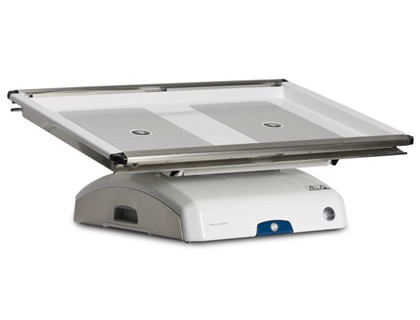
A New WAVE for the Future
Disposable bioreactors are increasingly used for cell cultivation because they improve process flexibility, shorten turnover times, and eliminate the requirement for cleaning and sterilization. This week at ESACT in Lille, France, GE Healthcare Life Sciences announced a new addition to the disposable bioreactor market; a next generation WAVE Bioreactor™, ReadyToProcess WAVE™ 25.
An early pioneer in the area of disposable bioreactors, the WAVE Bioreactor was the first single-use bioreactor system when it was presented to the bioprocessing community in 1996. Since then, the range of products has expanded to include larger scale systems and advanced optical sensor and control technologies. WAVE Bioreactor systems are today widely used in both research and manufacturing operations.
Design
WAVE Bioreactors have a design based on a noninvasive rocking technology that creates waves. The result is a simple but powerful instrument that meets all the conventional requirements for a bioreactor in terms of, for example, mixing and aeration. The rocking motion can be adjusted to provide conditions suitable for a variety of cell lines, such as robust CHO production cell lines with a high oxygen demand and more delicate primary cells and stem cells. WAVE Bioreactors also have a unique internal floating filter, which retains the cells in the bioreactor and filters only the media, eliminating the need for an external cell separator and flow loop.
Cell Culture Applications
The most popular applications include protein and virus production in smaller scale batch and fed-batch culture, and seed-train cultivations for scale-up to a larger bioreactor. For perfusion applications, the WAVE Bioreactor is quite flexible. For example, animal cell lines such as CHO, HEK, NS0, S2 and SF9 have been cultivated successfully in WAVE Bioreactor systems (1–7). In addition to the conventional applications, researchers are exploring novel ways of using the wave technology. I have included specific examples below of the innovative ways that the WAVE Bioreactor is being used in cell culture.
Seed-train Cultivation
In traditional seed-train expansion, a series of fed batch cultures are gradually increased in volume until adequate cell number is reached for the final production bioreactor. Maximum cell concentration limits split ratios and as a result several bioreactors are typically required for expansion. By using WAVE Bioreactors in perfusion mode, 5-10 fold higher split ratios have been achieved when compared with traditional batch culture. Utilizing perfusion and the WAVE Bioreactor system in seed-train cultivation can enable a reduction in the number of expansion steps and the reduction of the number of bioreactors used. Disposable bioreactors with just a few liters of working volume have the potential to inoculate up to 1,000 liters of production culture.
Insect Cell Cultivation
Insect cell culture can be shear-sensitive and it requires a high supply of oxygen, higher than mammalian cells require. The WAVE Bioreactor has the capability of providing a high oxygen supply, which makes it a good choice in insect cell cultivation. In addition, the Cellbag permits both cell expansion for infection and the infection itself to occur inside the bioreactor, which limits challenging transfers. In one example, insect cells were seeded at a low volume (10 liters), then cells were grown to the appropriate cell density and culture can was increased (100 liters) to allow for infection. The virus seed can also be conveniently expanded in a bioreactor of the same type.
Plant Cell Cultivation
Plant cell culture is becoming more widely used in many areas including plant research, and in both naturally occurring and recombinant compound production. WAVE Bioreactors provide a good choice for plant cells because of the low-shear factor. Plant cells can be particularly sensitive to shear stress and shear that is too high can cause a reduction in cell viability, changed morphology, impaired growth, and more. In addition, the absence of an internal impeller or sparger in the WAVE Bioreactor eliminates problems of clogging or tangling in hairy root cell culture. Finally, many plant cell cultures are light-dependent and the open design of the WAVE Bioreactor enables easy access to light from a source placed nearby.
The New WAVE
The latest WAVE bioreactor, ReadyToProcess WAVE 25, is available for cultures from 300 mL to 25 L scale, and combines the ease-of use that comes with the rocking technology as such, with intelligent control and advanced sensor technology. A short video preview of the system was made available online June 24th. Registration to watch the video can be done by following this link https://promo.gelifesciences.com/gl/K12355/mail-june.html.
Footnotes
-
1. Singh, V. Disposable bioreactor for cell culture using wave-induced agitation. Cytotechnology 30, 149–158 (1999).
-
2. Namdev, P. K. and Lio, P. Assessing a disposable bioreactor for attachment dependent cell cultures. BioPharm Int. 13, 44–50 (2000).
-
3. Tang Y. J. et al. Perfusion culture of hybridoma cells for hyperproduction of IgG(2a) monoclonal antibody in a wave bioreactor-perfusion culture system. Biotechnol. Prog. 23, 255–264 (2007).
-
4. Birch, J. R, and Racher, A. J. Antibody production. Adv. Drug Deliv. Rev, 58, 671−685 (2006).
-
5. Chartrain, M. and Chu, L. Development and production of commercial therapeutic monoclonal antibodies in mammalian cell expression systems: an overview of the current upstream technologies. Curr. Pharm. Biotechnol. 9, 447–467 (2008).
-
6. Clincke M. et al. Very high density of CHO cells in perfusion by ATF or TFF in WAVE bioreactor™. Part I: Effect of the cell density on the process. Biotechnol Prog. 2013 Feb 22. DOI: 10.1002/btpr.1704.
-
7. Clincke M. et al. Very high density of CHO cells in perfusion by ATF or TFF in WAVE bioreactor™. Part II: Applications for antibody production and cryopreservation. Biotechnol Prog. 2013 May 21. DOI: 10.1002/btpr.1703.